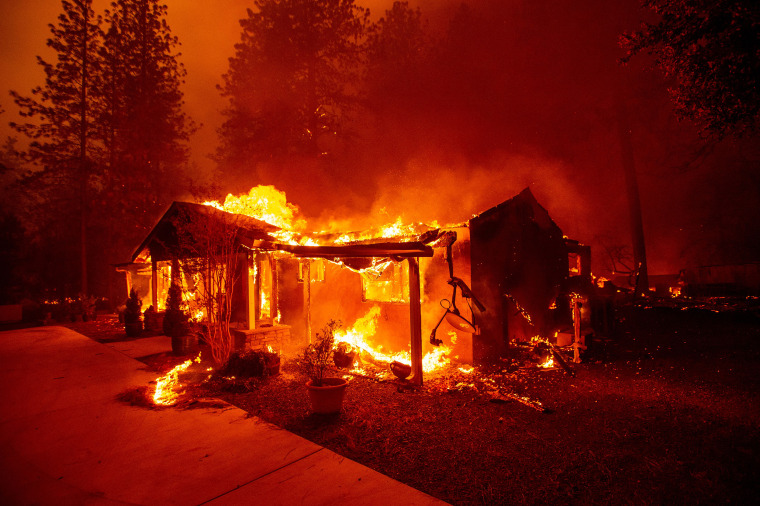begin quote from:
https://www.nbcnews.com/science/environment/california-wildfire-created-toxic-chromium-research-finds-rcna128644
California wildfires created toxic chromium, research finds

After some recent intense wildfires in Northern California, scientists tested samples of singed soil and were disturbed by their findings: It was laden with a cancer-causing metal called hexavalent chromium.
Scientists think the heat of severe wildfires can transform a benign version of the metal, which is found commonly in California soil, into a notorious carcinogen, according to new research published in the journal Nature Communications on Tuesday.
As climate change intensifies wildfires, scientists are trying to figure out just how dangerous their smoke can be for human health. Researchers have found dangerous metals — from burned-out cars, houses and farms — in previous fires. The new finding adds a surprising twist to the growing body of research and suggests that wildfires burning in natural areas could be pumping smoke containing a toxic metal into the atmosphere, too.
“I think it changes our risk analysis when you think about exposure to wildfire smoke,” said Scott Fendorf, a professor of earth system science at Stanford University and an author of the study.
Climate change could enhance the risk: Wildfires that burn hotter and for longer durations are more likely to turn harmless soil into carcinogenic dust and ash.
“Wildfires are more frequent because of climate change and the severity of the fires are greater,” Fendorf said. “You’re getting more exposure and you’re getting exposure to materials that are going to be more toxic.”
Hexavalent chromium is a group one carcinogen, according to the International Agency for Research on Cancer, meaning it is known to cause cancer in humans. Exposure to large amounts of hexavalent chromium is associated with lung cancer, according to a toxicological review of the substance by the Environmental Protection Agency, which evaluated decades of workplace exposures in people who worked in chrome plating and chromate pigment plants.
In a study of mice exposed to hexavalent chromium in drinking water for two years, some developed tumors in their mouths, small intestines and livers.
Hexavalent chromium is a well-known pollutant because it was the central chemical in the class-action lawsuit depicted in the film “Erin Brockovich” over chromium pollution in water in Hinkley, California, where the metal had been used to prevent corrosion in cooling tower water at a natural gas compressor station.
About 600 Hinkley residents settled an initial case with Pacific Gas & Electric Company (PG&E) for $333 million. PG&E paid another $315 million to settle other lawsuits, according to the Associated Press.
The California Air Resources Board earlier this year passed a rule to phase out hexavalent chromium at industrial facilities, saying in a news release that there was “no known safe level of exposure.”
In its trivalent form, chromium is relatively harmless and abundant. But heat that is more than 390 degrees Fahrenheit can catalyze chemical reactions that transform it into its more dangerous form, hexavalent chromium, the new study said.
Researchers visited the sites of wildfires in California’s North Coast Range, including the 2019 Kincade Fire and the Hennessey Fire in 2020 to look for hexavalent chromium. Theys sampled soil in four ecological preserves just after firefighters finished fighting the blazes, then returning about a year later for follow-up data.
Some areas sampled had “metal-rich geologies” — hot spots for trivalent chromium; others did not. The researchers collected about 38 total soil cores from both sites that had burned and sites that had not.
They found “dangerous” levels of hexavalent chromium levels at sites where wildfires burned intensely in chaparral shrubs growing in areas that had “serpentine” soils relatively rich with metal, the study said.
Areas without as much metal or where the fires burned at lower intensity — such as grasslands where fire passed quickly — tested much lower for hexavalent chromium.
Alandra Marie Lopez, a postdoctoral fellow at the Stanford Doerr School of Sustainability, said she spent several hours in fields sampling barren, ashy landscapes, only to find high levels of chromium back at the lab.
“That really catalyzed my concerns,” she said. “Firefighters are spending hours in the landscape mopping up burned areas.”
The researchers believe hexavalent chromium can travel in wildfire smoke, blow as dust after a fire is out and persist for months afterward.
More research is needed to understand the risk. The researchers are pursuing air sampling for hexavalent chromium during wildfire events and trying to predict risk based on geology and vegetation, Fendorf said.
Serpentine rock is common in fire-prone areas along the coastal mountains that run up and down the Pacific coast.
Researchers have been concerned for years that wildfires were creating toxic metal pollution.
After the Camp Fire in 2018, which burned almost 19,000 buildings, researchers found elevated levels of lead, zinc, calcium, iron and manganese in the smoke.
Some metals traveled more than 150 miles. During the fire, levels of lead — a potent neurotoxin — in Chico were about 50 times above average, California Air Resources Board researchers found.
“The toxics in wildfire are a tremendous concern,” said Barbara Weller, a pulmonary pathologist and toxicologist in the research division of the California Air Resources Board. “When a vehicle burns and when a house burns, there are vastly different components released potentially from that compared to a wildfire where you’ve got trees and grassland burning.”
She said the board and academic researchers are trying to get a handle on just how dangerous wildfire smoke is. This finding adds a new wrinkle.
“Toxics are always going to be a health concern, whether they’re produced by a natural source or manmade source. This brings out the continued concern for wildfire and climate change impacts,” Weller said. Serpentine minerals are ”found throughout California, so that certainly adds to the concern.”



No comments:
Post a Comment